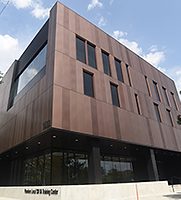New Plumbers 130 Training Center to Train Students for High-Tech Careers in Plumbing

With a plan to open in September of this year, the new 50,000-square-foot Plumbers Local 130 Training Center has everything needed to train tomorrow’s plumbers with real-world scenarios.
Apprentices learn how harvesting rainwater saves precious water. Harvesting tanks monitor how much water is being used within the building and how much water is being saved. The water is then recycled throughout the building as a responsible water conservation technique. Harvesting rainwater teaches apprentices this green technology that will help solve the world’s water shortages.
“Greywater” is also harvested from drinking fountains, showers and wash sinks, and used throughout the building as one more water conservation technique, while teaching apprentices methods of installation.
But the environmental consciousness doesn’t stop there. The green roof and multi-purpose room overlook an incredible view of the Chicago skyline, but also contain solar panels for students to learn solar technologies. Every room, nook and cranny of the training center is designed with a specific purpose. IT closets line the hallways. Labs with exposed piping and mirrors show students what goes on behind the walls.
A large underground pit filled with stone will teach apprentices how to dig through rock beds to install pipe, just like they would do on a jobsite. Three-story ceilings allow space for a three-ton crane so apprentices can learn how to rig properly. There’s space for 40 people to work with lifts at the same time, and 20 welding booths to accommodate the 20-student welding, soldering and brazing classes.
Local 130 Business Manager James Coyne, commented that the Joint Apprenticeship Committee trustees worked with Gensler Architects to create the building that will prepare plumbing apprentices for high tech careers well into the future.
“They really listened to our needs,” said Coyne. “Our building isn’t just beautiful; it’s also practical and flexible for the future. Our students, as well as our journeymen, are using technology for diagnostics and measurement. And, of course, they’re being taught AutoCAD and new software programs. Plumbing isn’t what it used to be so it’s fantastic that our building is adaptable and able to keep up with ongoing technology and equipment upgrades.”
According to the Bureau of Labor Statistics the plumbing industry is growing at a rate of 12 percent per year, with average salaries for experienced journeymen at $50+ per hour in the Chicago market. Apprentices make $16.75 an hour their first year, rising to $36.95 an hour in their fifth year of training. Apprenticeships have increased by 400 students at the Local 130 JAC Training Center over the past three years, with 20 women currently enrolled in the program. Three new instructors have been hired to keep up with the dramatic increases in apprenticeship enrollment.
“These students have the opportunity to become the best plumbers in the Chicagoland area,” said Craig Thomas, vice president of the West Suburban Association of Plumbing Contractors (WSA) and co-chairman of the JAC. “The contractor members of WSA need the best and brightest young people in order to maintain our edge in the industry. With this state-of-the-art facility, these apprentices will graduate with more knowledge of technology than any other students of plumbing.”
Students are in the classroom one day per week for three years. They read about plumbing processes, then walk across the hall to a wet lab and practice what they’ve learned. When they get to the jobsite, where they work with a contractor, they have had the experience of performing the skills they need, hands on.
Today’s plumbers work with the latest technology, like augmented reality and virtual reality, relying on mobile devices for updated information and fleet management. It’s a very different career than in the past. And it all starts with the union’s five-year training program — unmatched by any other and taught in a facility that matches the new, high-tech plumbing industry.
“This industry is becoming more and more desirable for young people or those entering a second career,” Coyne said. “Not only are they working with the latest technologies, but they can graduate making the same as someone with a four-year degree, but without any debt. We find that a lot of students and their parents are still unaware they can get paid while learning a valuable trade. Plus, the students in our program not only become licensed plumbers upon completion of their training, they also become State of Illinois licensed plumbers.”




